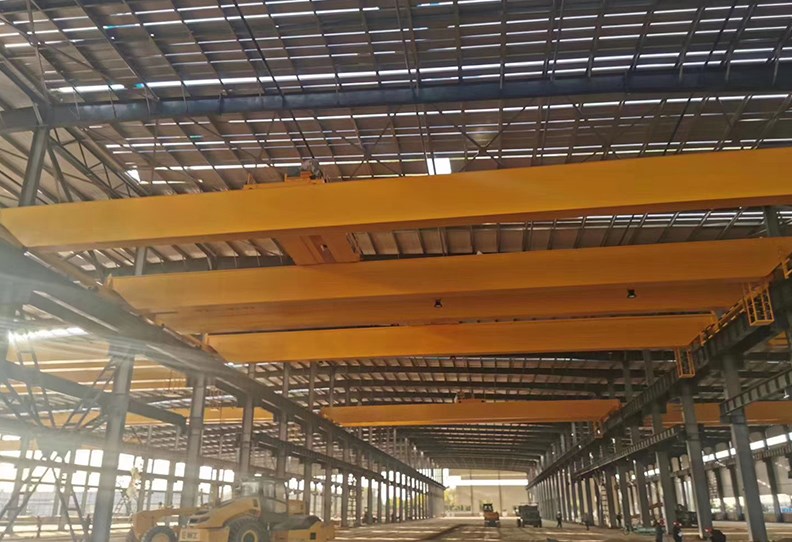How Does a 50-Ton Overhead Crane Work?
In industrial operations, the efficient movement of heavy loads is crucial for productivity. Overhead cranes, with their ability to lift substantial weights, stand as indispensable assets in various sectors, from manufacturing plants to warehouses. Among the diverse range of overhead cranes available, the 50-ton overhead crane holds a significant position due to its impressive lifting capacity. In this article, we will delve into the intricate workings of a 50-ton overhead crane, shedding light on its key components, operational mechanisms, and the role it plays in modern industrial settings.
Structural Framework
At the heart of a 50-ton overhead crane lies a robust structural framework that provides the necessary support and stability for heavy lifting operations. Typically, the crane's structure is composed of steel beams and girders, engineered to withstand the substantial loads it is designed to carry. The structural integrity of the crane is essential for ensuring safety and preventing any deformations or failures during operation.
Electric Hoist
The electric hoist is a critical component of the overhead crane responsible for lifting and lowering the load. In the case of a 50-ton overhead crane, the electric hoist is designed to handle weights up to 50 tons with precision and control. The hoist is equipped with a powerful motor, gears, and a braking system to ensure smooth and secure lifting operations. Operators can control the hoist using a pendant control or a remote control system, allowing for precise positioning of the load.
Trolley
The trolley is a movable component that runs along the bridge of the overhead crane, providing horizontal movement for the load. In a 50-ton overhead crane for sale, the trolley is engineered to carry the electric hoist and move it laterally across the span of the crane. This allows for flexibility in positioning the load and facilitates efficient material handling within the workspace. The trolley is typically powered by a separate motor, offering independent control for horizontal movements.
Bridge
The bridge, also known as the gantry, is the horizontal beam that spans the width of the working area. It supports the trolley and hoist, allowing them to move along the length of the crane. The bridge is mounted on end trucks, which consist of wheels that run on rails attached to the ceiling or supporting structure. In a 50-ton overhead crane, the bridge is designed to distribute the load evenly, ensuring stability and minimizing stress on the structural components.
End Trucks
End trucks are the components at either end of the bridge that house the wheels or rollers, enabling the crane to travel along the runway or rails. These trucks are equipped with a drive mechanism, typically an electric motor, that propels the crane forward or backward. The end trucks play a crucial role in the overall mobility of the overhead crane, allowing it to cover the entire length of the working area with ease.
Controls and Operator Interface
Modern 50-ton overhead cranes are equipped with advanced control systems that enhance the precision and safety of operations. Operators can control the crane's movements using a pendant control, which is a handheld device with buttons and switches for lifting, lowering, and traversing. Additionally, some cranes are equipped with remote control systems, enabling operators to manage the crane from a safe distance, providing a clear view of the lifting and positioning process.
Safety Features
Safety is a paramount consideration in the design and operation of overhead cranes. A 50-ton overhead crane comes equipped with a range of safety features to protect both personnel and materials. These features may include overload protection systems, emergency stop buttons, limit switches, and audible alarms. The overload protection system, for instance, prevents the crane from lifting loads beyond its rated capacity, reducing the risk of accidents and structural damage.
Power Supply
The power supply for a 50-ton overhead crane is typically electric. The crane is connected to a power source through a festoon system or conductor bars, ensuring a continuous and reliable power supply for the electric motors that drive the hoist, trolley, and bridge movements. This electrical power provides the necessary energy for the efficient and controlled lifting and traversing of heavy loads.
Maintenance Considerations
Regular maintenance is crucial to ensuring the optimal performance and longevity of a 50-ton overhead crane. Manufacturers provide maintenance guidelines, and routine inspections are conducted to identify and address any issues promptly. Components such as ropes, hooks, and brakes are regularly checked, and lubrication is applied to moving parts to minimize friction and wear. Maintenance personnel are trained to perform thorough examinations of the crane's structural integrity, electrical components, and safety features.
Conclusion
In conclusion, the operation of a 50-ton overhead crane involves a complex interplay of structural components, electrical systems, and safety features. This powerful piece of machinery plays a pivotal role in material handling and lifting operations across various industries. The integration of advanced technologies, precision controls, and robust safety measures ensures that a 50-ton overhead crane operates efficiently and safely, meeting the demands of modern industrial applications. As technology continues to advance, we can expect further innovations in the design and functionality of overhead cranes, reinforcing their position as indispensable tools in the world of heavy-duty lifting.



Comments
Post a Comment